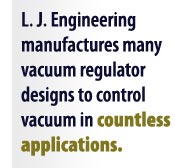
 Our vacuum regulators are used in vacuum systems to automatically maintain the vacuum at the desired setting. The goal of a vacuum regulator is to maintain the desired vacuum setting regardless of vacuum leakage and flow in the vacuum system. L. J. Engineering manufactures many different types of vacuum regulators designed to control the strength of vacuum in countless applications. These applications include: semiconductor processing equipment, biomedical fluid analysis, vacuum instrument calibration, precision clamping, vacuum chucking glass materials, delicate parts pick and place equipment, bottle labeling, skin care equipment, vacuum leak testing, low pressure testing, ink meniscus control, vacuum bagging composites, etc...
Our vacuum regulators are used in vacuum systems to automatically maintain the vacuum at the desired setting. The goal of a vacuum regulator is to maintain the desired vacuum setting regardless of vacuum leakage and flow in the vacuum system. L. J. Engineering manufactures many different types of vacuum regulators designed to control the strength of vacuum in countless applications. These applications include: semiconductor processing equipment, biomedical fluid analysis, vacuum instrument calibration, precision clamping, vacuum chucking glass materials, delicate parts pick and place equipment, bottle labeling, skin care equipment, vacuum leak testing, low pressure testing, ink meniscus control, vacuum bagging composites, etc...
Vacuum regulators are used in sub-atmospheric pressure systems to automatically maintain vacuum at the desired “partial” vacuum setting, regardless of leakage and or flow into the system. L. J. Engineering’s regulators function by precisely throttling the vacuum supply to maintain the desired vacuum setting downstream from the regulator. A vacuum regulator as opposed to vacuum relief valve; allows multiple vacuum regulators to be used from a single vacuum source, with each regulator operating at different vacuum settings. Vacuum relief valves, which are sometimes referred to, as vacuum breakers are typically limited to a single vacuum setting within a vacuum system with a dedicated vacuum pump. This occurs because the relief valve will limit the vacuum in the manifold to whatever the vacuum relief setting is set at.
L. J. Engineering manufactures both mechanical and electronically controlled vacuum regulators that reference either absolute or atmospheric (differential) pressure.
Absolute pressure is measured relative to the absolute pressure scale, where zero pressure occurs at perfect vacuum (outer space). Whereas differential pressure is measured relative to atmospheric pressure. Therefore, zero vacuum will be equal to the atmospheric pressure.
Differential referenced vacuum regulators are useful in applications that require a constant vacuum that is only slightly lower than atmospheric pressure since it will eliminate the small variation which results from constantly changing barometric pressure. Vacuum regulators that reference atmospheric pressure are useful in applications such as low force vacuum clamping or where the desired vacuum setting is only slightly less than atmospheric pressure. These applications require the regulator to reference atmospheric pressure so the regulator’s output will automatically compensate for barometric pressure changes that would otherwise affect the regulated vacuum setting.
Absolute referenced vacuum regulators are ideal for applications that require vacuum referenced to absolute pressure settings such as distilling at a set vapor pressure, cryogenic temperature control, altitude simulation chambers and instrumentation or calibration of absolute pressure equipment.

| Please select a conversion method |
Conversions |
|
|
|
| Calculations are approximate. Please verify all conersions. |


 Our vacuum regulators are used in vacuum systems to automatically maintain the vacuum at the desired setting. The goal of a vacuum regulator is to maintain the desired vacuum setting regardless of vacuum leakage and flow in the vacuum system. L. J. Engineering manufactures many different types of vacuum regulators designed to control the strength of vacuum in countless applications. These applications include: semiconductor processing equipment, biomedical fluid analysis, vacuum instrument calibration, precision clamping, vacuum chucking glass materials, delicate parts pick and place equipment, bottle labeling, skin care equipment, vacuum leak testing, low pressure testing, ink meniscus control, vacuum bagging composites, etc...
Our vacuum regulators are used in vacuum systems to automatically maintain the vacuum at the desired setting. The goal of a vacuum regulator is to maintain the desired vacuum setting regardless of vacuum leakage and flow in the vacuum system. L. J. Engineering manufactures many different types of vacuum regulators designed to control the strength of vacuum in countless applications. These applications include: semiconductor processing equipment, biomedical fluid analysis, vacuum instrument calibration, precision clamping, vacuum chucking glass materials, delicate parts pick and place equipment, bottle labeling, skin care equipment, vacuum leak testing, low pressure testing, ink meniscus control, vacuum bagging composites, etc... 